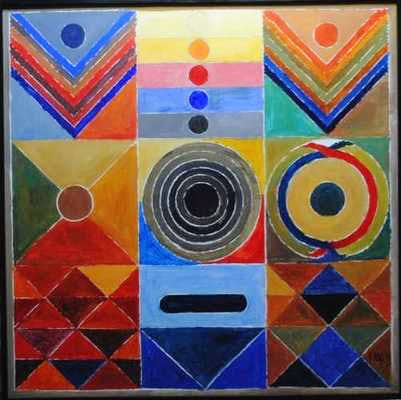It is always the final product that charts its way to fame, or the murky backs of warehouses. Some are destroyed with time and others kept in captivity, only for the eyes of the beholder, and the rest being the majority, rise from nothingness to sparkle on display. What is it, really? This business of artists, where does it stem from? We’re taking a peek into their studios, an arena or a battlefield if you may, the very hub of creative conception.
Studio 101 | S.H. Raza
By Amisha Chowbey
In Conversation with Syed Haider Raza, The Master
Who is he?
The most adored Indian artist. The Master.
What does he paint?
Abstract canvases, revolving around the Bindu.
Humble beginnings?
In retrospect, not at all.
Was he a part of an Art movement?
He founded the Progressive Artists’ Group with FN Souza in 1947.
What about awards?
He was honored with the Padma Vibhushan this year.
What’s the scene under the hammer?
A work titled Saurashtra sold for Rs. 16.42 crore at Christie’s in June 2010.
… And that makes him?
The most expensive modern Indian artist.
It was a beautiful sight, to watch him paint. His studio atop the quaint medieval village of Gorbio in the French Riviera left us speechless. All we wanted to do is watch him paint and wonder whether he would ever return to create more works with such enthusiasm, back in his Motherland. After devoting six decades in France, love finally pulled him back to Delhi, where he continues to work. It’s surreal, almost like a dream to walk into his studio in the heart of Delhi. At the age of 91, he still maintains his status as a jovial artist, kicking back with a glass of wine at the end of yet another productive day. For him, art is nature, not a habit anymore.
The thought of coming back to India was persistent and the longing was immense. An iconic canvas from the early 1980s expressed the desire. Across the canvas were the words Ma Laut Kar Jab Aunga Toh Kya Launga?* written in the Devnagari script. He brought back the gift of his creative genius. In 2011, an artist returned home.
The studio is a space of immense spirituality, a concentration of such intense creativity that it could make one feel uncomfortable and small. The words are sparse, and the silence seems more comfortable. The only source of respite is to walk around and face canvases, concentrate on mostly big black dots of Raza’s iconic Bindu. They are dark spaces of nothingness and fairly easy to be trapped in. Why Black? “Black for me is the mother color, it represents the Mother Earth from which all life forms take birth. I do paint the Bindu in other colors as well, but I prefer the black in spirituality, the journey from darkness towards the light.” Maybe if I saw the same canvas in a gallery, I might dismiss it as paint on canvas but here, at its very point of conception, the meditative quality makes me loosen up on consciousness. It’s a full circle – the artist, his pictorial thoughts and a viewer. It’s the paint that talks… who needs words?
“I feel at peace with myself, especially when I paint,” he says, talking about his current body of work on the idea of swadharm. The numerous canvases are lined up along the wall. The one on the easel still has blank patches here and there. “What is your favorite color, Raza sahib?” and with this follows a thoughtful silence. “It changes everyday”, he answers with a laugh, “I like the color of your scarf. Yes, today I like orange.” When you walk away, his grin will linger on, and a song if you’re lucky enough!
*”Mother! What shall I fetch you when I come back home?” A line from a poem written by his very close friend, Ashok Vajpeyi.
About the Author | Amisha Chowbey is an art lover-turned-writer, interacting with artists for experience-based features, working towards restoring the fading sensitivity towards artworks. She lives and works in New Delhi.

